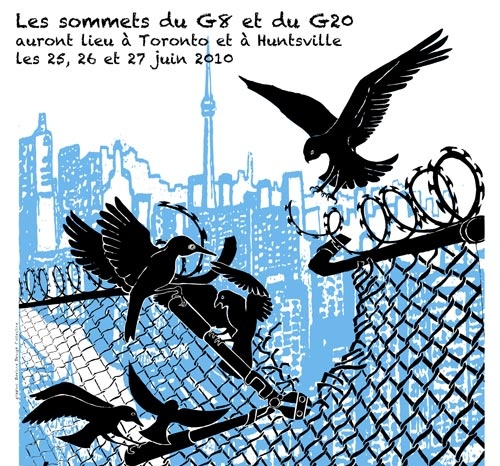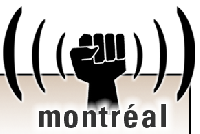 |
 |
 |
 |
 |
 |
|
 |
 |
 |
 |
 |
 |
 |
Régions du Québec |  |
 |
 |
|
 |
 |
|
 |
 |
|
 |
 |
 |
 |
 |
 |
Temas |  |
 |
 |
|
 |
 |
|
 |
|
 |
 |
 |
Enron versus Argentina: The WEF in New York City
After several days of demonstrations -- and over 200 total arrests -- Enron and Argentina were the two dominant poles of reference for the thousands of protesters in the streets of Manhattan in opposition to the Annual Meeting of the World Economic Forum(WEF).
ENRON VERSUS ARGENTINA: THE WEF IN NEW YORK CITY
[NOTE: A previous article about the WEF protests, "Capitalists and Anti-Capitalists" is accessible at:
http://nyc-cache.phillyimc.org/front.php3article_id=17426]
NEW YORK CITY, February 4, 2002 -- After several days of demonstrations -- and over 200 total arrests -- Enron and Argentina were the two dominant poles of reference for the thousands of protesters in the streets of Manhattan in opposition to the Annual Meeting of the World Economic Forum(WEF).
"They are Enron, we are Argentina!" was the popular chant today outside the offices of Andersen Consulting, the corporate accounting firm accused of "cooking the books" of the now-bankrupt energy conglomerate Enron Corporation. The protest moved to the nearby Argentine consulate, in solidarity with the recent anti-IMF rebellion in Argentina that has become a potent symbol of resistance to global capitalism, and whose example resonated among demonstrators in New York.
Enron -- a WEF alumnus that was unceremoniously dropped from the exclusive 1000-plus corporate members of the Forum -- was targeted as an indisputable example of high level collusion by political elites and corporate executives. Dubbed the "White Executive Fiasco" on some placards and stickers, the WEF was regularly critiqued by demonstrators for actively promoting similar political-corporate collusion for private profit at public expense.
A "Miss Mya Cash", a member of an affinity group called "Billionaires for Bush and [New York City Mayor Michael] Bloomberg", sarcastically admonished Enron at a press conference wrapping up the weekend of protests: "Shame on you Enron for getting caught! You need more creative accountants and better PR!"
The days of protest against the WEF occurred under an enormous police mobilization in New York (which has a regular force of 40,000 police). Permitted protests, including the main march of anywhere between 10-20,000 people on Saturday afternoon, were constantly lined by rows of police, and systematically corralled into a stifling single lane of traffic and crowded protest pens.
In the frustrated words of one protester on the weekend: "This is not a legal demo, this is a repressed demo." Another organizer remarked afterwards: "To hell with permits. We held out an olive branch and our fingers were broken."
[Protest estimates by mainstream sources were faulty, with CNN, for example, claiming only a few thousand protesters on Saturday. It's true there were a few thousand at an initial demonstration on Saturday morning, but the later march had many many thousands more. The latter demo was not covered by CNN, although the New York Times acknowledged at least 7000 present. Reporters accredited with the New York City Indymedia Center estimated between 10-20,000 in total on Saturday, with main protest being almost one mile in length.]
An antiquated anti-mask law, which dates back to 1845, was used to target protesters throughout the weekend. Lines of police were placed in front of seemingly every Starbucks, GAP, NIKE as well as the many luxury stores and boutiques throughout midtown Manhattan, while ever-present overhead helicopters completed the scene.
There were three main arrest incidents on the weekend, all involving swarms of uniformed and plainclothes police surrounding protesters and attacking with billy-clubs and pepper-spray. The first mass arrests occurred at the legal demonstration on Saturday, when at least 150 police mobbed demonstrators south of Central Park after most of the march was thinned out along what was to be a one-mile long procession of protesters. The police trap seemingly targeted a group of demonstrators carrying plexiglass shields painted with colorful images.
Janick Lewis -- a 16 year-old high school student from Alexandria, Virginia who says he's "an anarchist, not a terrorist" -- was part of the shield group that was brusquely arrested by riot police and plainclothes officers. Released 30 hours later, after detention at the Brooklyn Naval Yard that was used as a temporary prison, he was charged with "illegal assembly" at what was supposedly a legally permitted demonstration.
In his words, the shields were intended both as signs and as a form of self-protection: "We wanted to, if necessary, protect protesters so our right to assemble would be respected."
The twenty shields were painted with images of trees, and caricatures of corporate executives drinking martinis on the ruins of the World Trade Center -- a reference to the gala black-tie party held by the WEF at the New York Stock Exchange on Saturday night. One shield depicted a hand holding a plant, with another hand reaching out and the caption below reading, "Pass it on."
Like the shield arrests, other police interventions on the weekend were also unprovoked, with the only apparent aim to be to prevent any show of dissent beyond the control of police permits and protest pens. Early Sunday afternoon, 87 arrests were made in the East Village of New York as members of the Anti-Capitalist Convergence (ACC) and their supporters attempted to march on the streets without a permit.
According to a source monitoring a police scanner, one officer remarked, "Lock them up so we can go home and watch the game," a reference to the Super Bowl on Sunday. New York City Mayor, Michael Bloomberg, and Police Commissioner, Raymond Kelly, briefly observed the mass arrests.
According to the People's Law Collective, the bulk of arrests were for minor charges like "illegal assembly" or "disturbing the peace". There were reports of at least two Canadians being caught in the arrest grabs, one each from Toronto and Montreal.
Despite the arrests, the paucity of media coverage(especially when the protests did not turn "violent") and the enormous police mobilization, protest organizers and participants retained a sense of accomplishment. According to Eric Laursen of the Another World is Possible (AWIP) Coalition: "We showed the success of organizing a mass action, even after 9-11, without resorting to leaders, bosses or hierarchies." David Graeber of the ACC added: "This was perhaps the first action that was entirely put together by the "bad" protesters".
Both speakers were alluding to the decision, both explicit and implicit, of major American unions and NGOs to not significantly mobilize for protests against the WEF. That left the bulk of organizing work to groups like AWIP and the ACC, which emerged from the anarchist-oriented New York City Direct Action Network.
The decision to protest openly on the streets of New York, in an explicitly anti-capitalist and anti-war protest, attracted many thousands, and countered the conventional wisdom of the inappropriateness of protesting in New York City months after September 11. According to Laursen, "It's an insult to New Yorkers to think that they can't protest. This is a city that tolerates dissent."
"I think its inappropriate to keep your mouth shut," added Payal Parekh, a Boston-based activist with the South Asian Center who helped to facilitate street puppets and theatre on the weekend. "These protests show that people in New York and around the country are not going to be repressed into accepting a police state."
L.A. Kauffman, a longtime New York-based radical journalist, and activist with Reclaim the Streets, summed up the mood of many protesters in New York:
"It was a horrible Fall here and there was a lot of anxiety. What we proved is that despite incredible intimation and fear-mongering, large numbers of people still came to New York City and we stood our ground. We kept open our political space that [US Attorney General John] Ashcroft and the US government are trying to shut down."
In the face of thousands of ever-present police, the ability to undertake effective civil disobedience and direct action became almost impossible, despite the efforts of a range of affinity groups. This was the cause of some disappointment for many activists. In Kauffman's words:
"Some people were frustrated by the constraints under which we operated here, but holding these actions at all was a bold step. Our movement is very much alive and seasoned enough to make solid and strategic choices based on circumstances."
She concludes: "It was confrontational enough just being on the streets."
[by Jaggi Singh, for rabble.ca, a-infos and indymedia]
---
For more info, check http://nyc.indymedia.org
A previous article, "Capitalists and Anti-Capitalists" is available at
http://nyc-cache.phillyimc.org/front.php3?article_id=17426]
 |
 |
 |
 |
G20 Especial |  |
 |
 |
|
 |
 |
|
 |
Ofrecemos varios informes independientes y testimonios ...

Lista de acciones durante el 'contracumbre' a Toronto! Algunos medios independientes en Toronto G20 Centro de medios alternativos http://2010.mediacoop.ca Media Co-op Toronto http://toronto.mediacoop.ca Toronto Community Mobilization www.attacktheroots.net (en Inglés) |
 |
 |
 |
 |
 |
 |
 |
CMAQ: Vie associative |  |
 |
 |
|
 |
 |
|
 |
 Collectif à Québec: n'existe plus. Impliquez-vous ! |
 |
 |
 |
 |
 |
 |
 |
 |
|
 |
 |
 |
Ceci est un média alternatif de publication ouverte. Le collectif CMAQ, qui gère la validation des contributions sur le Indymedia-Québec, n'endosse aucunement les propos et ne juge pas de la véracité des informations. Ce sont les commentaires des Internautes, comme vous, qui servent à évaluer la qualité de l'information. Nous avons néanmoins une
Politique éditoriale
, qui essentiellement demande que les contributions portent sur une question d'émancipation et ne proviennent pas de médias commerciaux.
This is an alternative media using open publishing. The CMAQ collective, who validates the posts submitted on the Indymedia-Quebec, does not endorse in any way the opinions and statements and does not judge if the information is correct or true. The quality of the information is evaluated by the comments from Internet surfers, like yourself. We nonetheless have an
Editorial Policy
, which essentially requires that posts be related to questions of emancipation and does not come from a commercial media.


